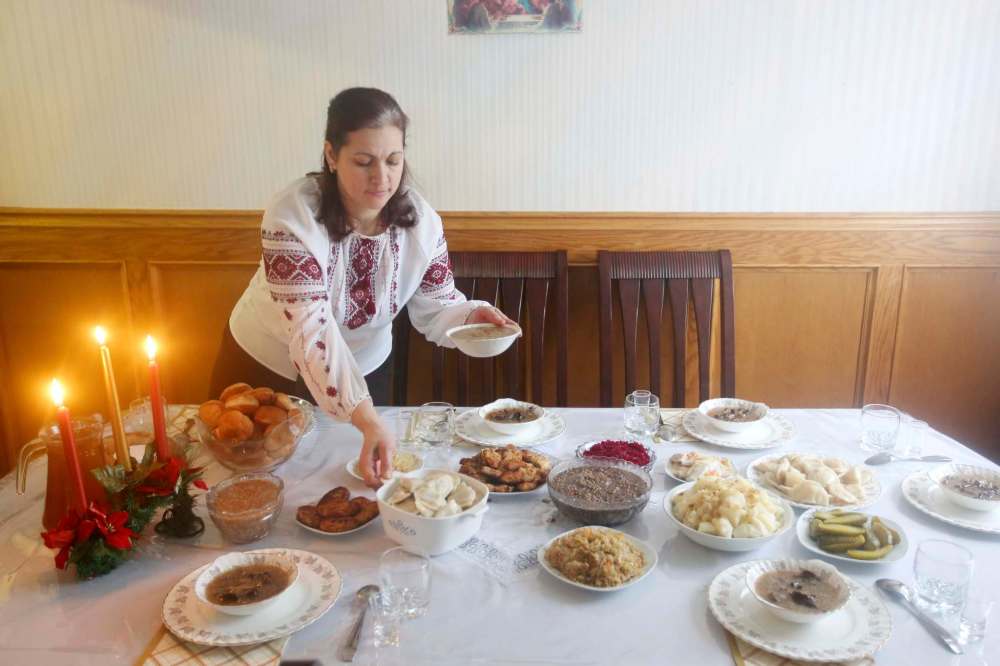Ukrainian Christmas twists with the times
Advertisement
Read this article for free:
or
Already have an account? Log in here »
To continue reading, please subscribe:
Monthly Digital Subscription
$1 per week for 24 weeks*
- Enjoy unlimited reading on winnipegfreepress.com
- Read the E-Edition, our digital replica newspaper
- Access News Break, our award-winning app
- Play interactive puzzles
*Billed as $4.00 plus GST every four weeks. After 24 weeks, price increases to the regular rate of $19.00 plus GST every four weeks. Offer available to new and qualified returning subscribers only. Cancel any time.
Monthly Digital Subscription
$4.75/week*
- Enjoy unlimited reading on winnipegfreepress.com
- Read the E-Edition, our digital replica newspaper
- Access News Break, our award-winning app
- Play interactive puzzles
*Billed as $19 plus GST every four weeks. Cancel any time.
To continue reading, please subscribe:
Add Free Press access to your Brandon Sun subscription for only an additional
$1 for the first 4 weeks*
*Your next subscription payment will increase by $1.00 and you will be charged $16.99 plus GST for four weeks. After four weeks, your payment will increase to $23.99 plus GST every four weeks.
Read unlimited articles for free today:
or
Already have an account? Log in here »
Hey there, time traveller!
This article was published 06/01/2018 (2840 days ago), so information in it may no longer be current.
Ukrainian Christmas is about Christmas Eve. There is reverence, spirituality, antiquity and it is quite different from the North American Christmas.
Throughout Canada and still to this day, Ukrainian families and churches continue to observe the traditional date of Ukrainian Christmas on Jan. 7 despite the pressures of modern society to change. Ukrainian Christmas is a more religious observance. Many of today’s Ukrainian customs come from ancient times — in fact, Ukrainian customs date from pre-Christian days. But when Ukraine accepted Christianity in AD 988, it became much simpler to incorporate the ideals of Christianity into the way of life, a life that was based on agriculture.
After the official introduction of Christianity, many of the folk customs and rites were accepted by the church and adapted to the spirit of the Christian religion. The colourful celebration as part of the Ukrainian Christmas traditions is the actual Christmas Eve or “Sviatay Vechir,” which revolves around the 12-course Lenten supper. This is a family affair or reunion commemorating ancestors, and the religious observance of Christmas; it is acknowledged on Jan. 6 by the Julian calendar prior to Ukrainian Christmas Day for ecclesiastical purposes.

On Christmas Eve, a lighted candle is traditionally placed in the window as an invitation to any homeless stranger, or perchance a lost soul, to join the family in celebrating the birth of Christ. The first star in the eastern sky announces the time for the commencement of the “Sviata Vechera” or “Holy Supper.”
The family begins setting the table for the “Holy Supper.” First the table is strewn with a small amount of hay or straw in memory of the Christ Child born in the manger. A kolach (braided loaf of bread) is placed as a central table decoration. The word “kolach” derives from “kolo,” which means round or circular, and is a symbol of the sun. A candle is stuck into the top of the kolach, this represents the light of the world, or the star that shone over the stable in Bethlehem.
With the tradition, setting the dishes on the table for the immediate family members and for members who have died during the year, the household or “Hospodar” brings in a sheaf of wheat or “Didukh” (grandfather’s spirit), a symbol of the gathering of the family. The Didukh is placed in a corner of the dining room beneath a religious icon, or is replaced with a few stalks of wheat placed in a vase. This remains until Jan. 14 (Ukrainian New Year-Malanka).
The family begins the Holy Supper with the Lord’s Prayer. The Hospodar gives the traditional greeting “Khrystos Razhdayet’sia” (Christ is Born). Everyone at the table replies “Slavite Yoho” (Let Us Praise Him). In the past, it was customary for the Hospodar to throw a spoonful of kutya (a traditional wheat dish) to the ceiling with an invocation for a bountiful harvest. If the kutya stuck to the ceiling, wishes would be answered. Sviatay Vehir consisted of 12 meatless dishes symbolizing the 12 apostles. After Sviata Vechera, all family members join in singing carols, socialize and at midnight attend Holy Liturgy. In Canada, church services are often celebrated before midnight and there is a liturgy service next day on Ukrainian Christmas (Rizdvo).
Recently, Ukrainian Canadians celebrated the 125th anniversary of the first Ukrainian settlers to Canada who adopted this homeland. During that time, Ukrainian-Canadians have incorporated many Canadian traditions into their Christmas customs. On the other hand, rarely would you find someone with even a few drops of Ukrainian blood who doesn’t celebrate Rizdvo-Ukrainian Christmas with at least some of the rituals and traditions mentioned.

A few of the aspects of traditions have been forgotten or are not practical for urban life, but still some Ukrainian-Canadians who are fifth and sixth generations carry on the traditional Ukrainian Christmas. Ukrainian customs are Canadian traditions!
Peter J. Manastyrsky is a Winnipeg writer.
The Free Press is committed to covering faith in Manitoba. If you appreciate that coverage, help us do more! Your contribution of $10, $25 or more will allow us to deepen our reporting about faith in the province. Thanks! BECOME A FAITH JOURNALISM SUPPORTER
The Free Press acknowledges the financial support it receives from members of the city’s faith community, which makes our coverage of religion possible.


